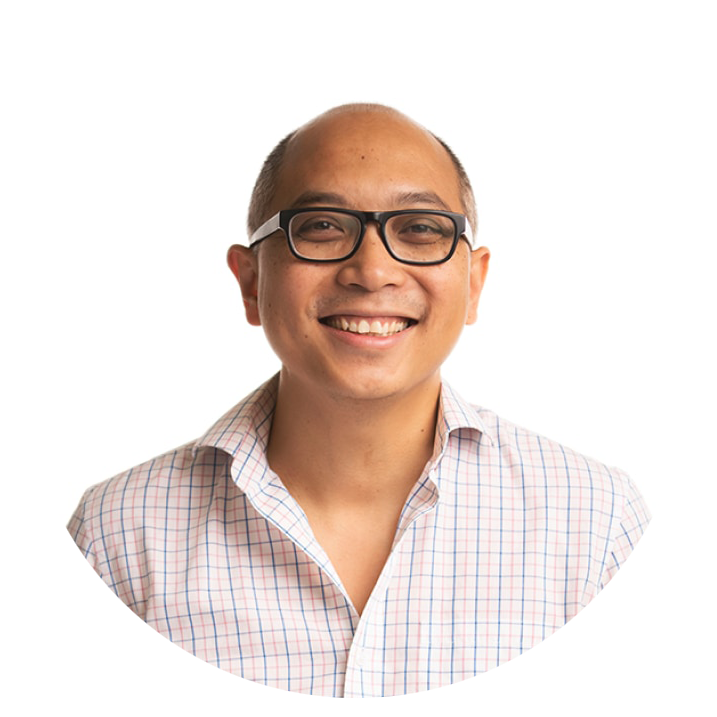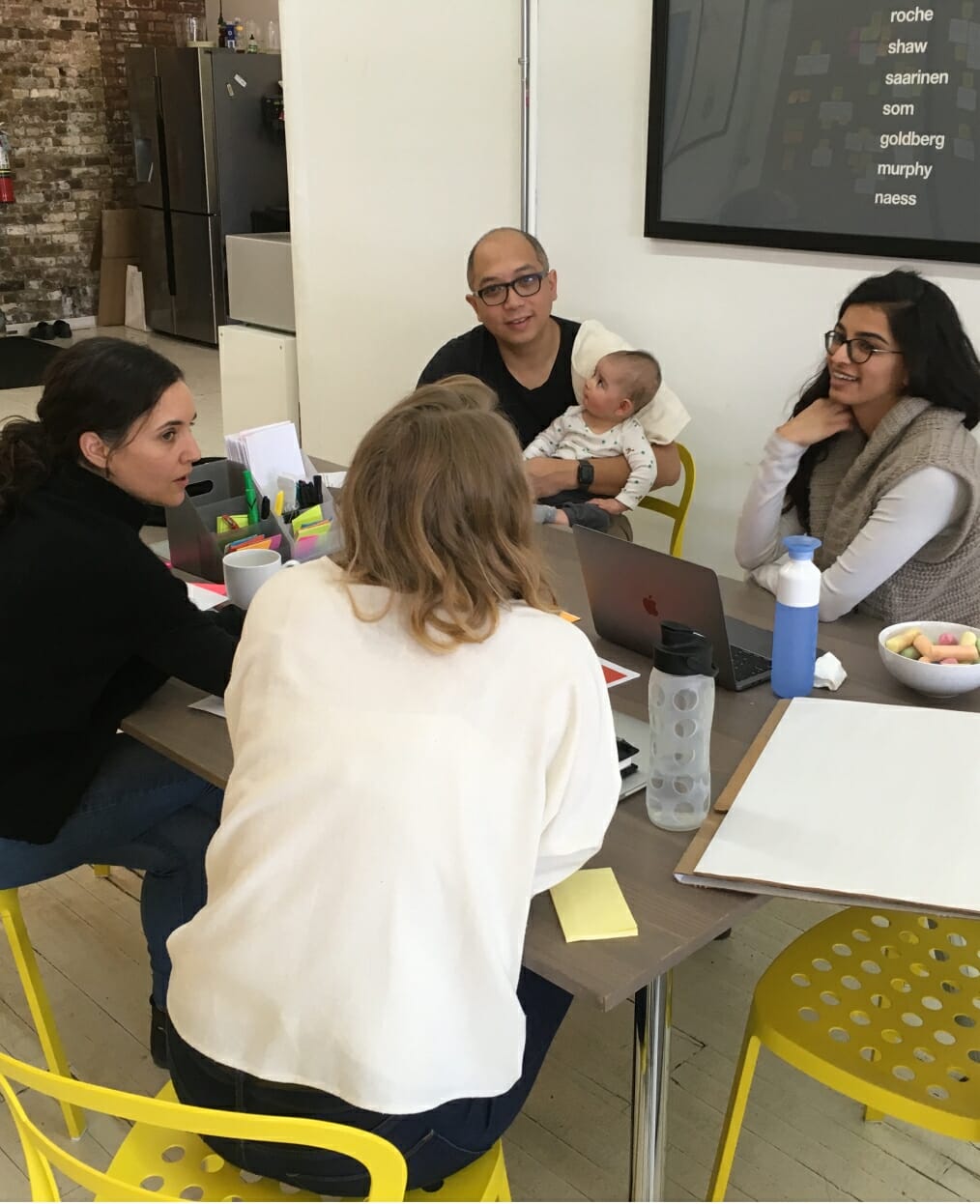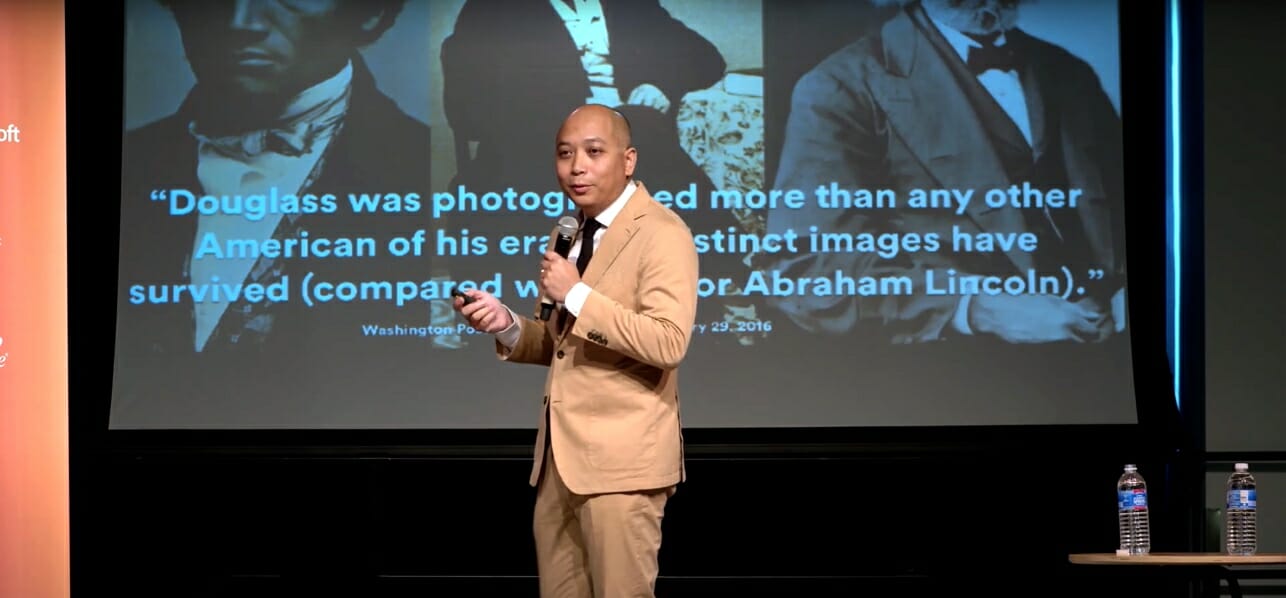
Interview with George Aye
Ever wonder what a Director of Innovation does? Curious about human-centered design? Listen as design leader George Aye and CoDesign Collaborative’s J.R. Uretsky discuss his work as the Director of Innovation and Co-founder of Greater Good Studio.
Listen
George Aye Interview Transcription
George: Hi, my name’s George. I’m the Co-founder and Director of Innovation at Greater Good Studio. We are based in Chicago. I’m one of the leadership at the studio, and I guide projects as well as have a lot of early conversations with clients framing what the project should be.
J.R.: What does the day-to-day look like for you at Greater Good Studio?
George: A lot of email. My calendar is filled with meetings, probably even more so now because of zoom, but even before zoom, it was mostly meetings and calls. Then the rest of the time is spent with project teams, keeping an eye on multiple projects as they go through their progression. I’d say I’m far less involved in the day-to-day work of a project than the teams are. But I am guiding anywhere between three to four different projects at any one time. I think a big part of the work is still designing the business and what that entails, like career development and internal strategy. So it’s about a three-way split of my time between business development, current projects, and then internal projects.
J.R.: As I was reading about Greater Good, a phrase came up that I was intrigued by, and it might be totally obvious, but I’m wondering if you can speak to this idea of human-centered design, what does that mean in general and what does it mean to Greater Good? And how does that apply to your day-to-day?

George: Human-centeredness or human-centered design is a pretty integral component of the work that we do. I’d say without that training, experience, and language, I’m not sure if there would be a business, or if there would even be a Greater Good Studio. That being said, it’s been 10 years of running this business being fairly vocal about the critique of human-centered design because of how it pertains to the work we do in the social sector. It’s almost like immigrants leaving a human-centered design mainland and then striking out on our own to set up a new island and trying to work out what are the traditions we want to keep and what are the ones we want to no longer adhere to. And in doing so, when we let go of some traditions, do we have a strong understanding of what we’ve learned? In some cases, human-centeredness could be quite harmful, it could be quite pejorative. It can center some people and not others and can exacerbate social issues that probably don’t even need to be worked on any further. So what we’ve been trying to work on is asking what adjacent practices alongside human-centered design should we learn from? I don’t think we could ever say that we are experts in any one of those other areas. For instance, community organizing is an area that we have, I think, a professional crush on, but it wouldn’t be fair to say we are practicing some of the methods of organizers without claiming to be them. The people who do that full-time have that discipline well under control, but we are fans of and appreciate those disciplines alongside human-centered design.

J.R.: Why are you so invested in this particular way of thinking?
George: I think there’s a few different threads here. One is that I was shown, by my family and my dad in particular, that there is a pursuit of earning a living that specifically creates as little harm as possible and to make your money in a way that helps others maintain their principles. So one interpretation of that was I should probably become a doctor one day. I struggled thinking about this in high school and not making it through to college and failing miserably going down that medicine-related path until realizing I don’t think I have pre-med written all over me. I’m not really the right fit for this. So if I’m gonna be a designer, which was the thing I’ve actually wanted to do, how can I adapt that path? And that’s really hard to do. Being a designer typically means you’re making money for corporate clients. You’re using design for some commercial end. There’s almost no way of avoiding it. So a good 10 years of my career was spent doing that before I realized that I don’t know if I wanted to keep pretending that it wasn’t bothering me. I started to notice how it was a little weird that we would speak publicly about the work we do that has some social benefit and then the other stuff like designing for BP or frozen pizza companies—we just conveniently didn’t talk about as much. That’s weird. Isn’t it? That we are deliberately vocal about the good stuff. Why does this have a social cache? And this one doesn’t? So when I worked in these commercial studios, I kept noticing this double logic, and it just didn’t seem to compute with me anymore.
J.R.: You mentioned your family before. Can you tell me where you grew up and what were your hobbies or favorite activities as a kid?
George: I grew up in the south of England. We moved as a family when I was very young from Burma to the UK. One of only a handful of Asian faces. There was a lot of assimilation to a British culture and upbringing, which has its own issues. I had a real attraction to wanting to draw or build things, but I don’t think I’d understood that was a career path but I was carrying over so much of this strongly felt desire to fit into an Asian immigrant mode of becoming a doctor.
So, I came to design very late. Even now, I think I still carry a lot of hangups about whether I see myself as a designer, whether I identify as one, and whether I feel confident about saying it. I do think that growing up in a Burmese Buddhist household definitely shaped my idea of what a career would look like. It’s this braiding of wanting to have something larger beyond just making money, but also wrestling with having to make some money in order to live in this world. So figuring out how I can marry some of those goals together has been a struggle.
So I think if I did allow myself to think about something, probably making toys or designing fun things or like mechanical objects, because I enjoyed a lot of that. But I thought, well, that’s cute, but that’s never gonna be a job. Obviously, I have to do something else. And it’s funny that I’ve ended up coming back to it so often because I feel like there is a certain affinity to it that I still enjoy. But what’s interesting now is that I don’t design stuff. If design is capable of shaping and influencing context, the question becomes, what should those things be? Is it enough to simply design stuff anymore, but rather the systems in which stuff is created, or the systems in which people operate were definitely not something I thought you could do. When I was a kid, there’s no pretense of wanting to be a systems designer. But I was surrounded by a lot of really smart system thinkers when I was at this big design studio and that really helped shape and continues to influence the role of what a designer can be. I’ve benefited so much from them, learning how to be a designer. If you apply the ability to create new things to a career, could that not then shape what you do with design that you’ve been studying or training in? I think you can. And that’s where I’ve ended up thinking maybe we should design other things rather than injection boards, plastic objects, apps or phones and such.
If design is capable of shaping and influencing context, the question becomes, what should those things be? Is it enough to simply design stuff anymore, but rather the systems in which stuff is created, or the systems in which people operate were definitely not something I thought you could do.
J.R.: Were there any experiences from your schooling that particularly stick out as something that informed where you are now, whether that’s in your job or in your life in general?
George: I never did my master’s, I only had an undergrad degree. I don’t have a lot of schooling as compared to a lot of my teammates, actually. I might reference what we talked about earlier, like test prep and disentangling some of the self-image one has based on test results. I think it’s less important to describe the impact on me, which is that it wasn’t great, but actually just how common it is that so many people have a self-image based on these test scores. They can haunt you for a very long time. In some other families, test prep and scores weren’t as sticky, so those kids are burdened by those stories as much and, perhaps, therefore, are given new or different chances. So I can’t help but think about the work we do as a studio—how much of the work we do in the social sector is about designing against harmful narratives about people. They have nothing to do with one’s inherent worth but actually to do with random things like taking a test one day or getting a parking ticket, or getting arrested for failing to stop at a stop sign, all of these random events can shape and influence people’s views, especially groups of people. A lot of our work is about trying to get below the story that everyone knows. What is the actual story happening in this particular case with this family at this moment? And a lot of those stories are very different from the more common story that’s out there.
J.R.: I mean, I sort of have to ask, as you and your co-founder and partner are thinking through these complicated stories and strategies, how are you not mentally exhausted all the time? What do you do to keep yourself sane?
George: We are pretty tired. I’d say it’s pretty exhausting. I hear from my team that they were exhausted before the pandemic and that they’ve said when they’ve worked in other design studios that the work of a 40-hour week feels more like an 80-hour week because the work is pretty heavy. I hope that that doesn’t sound too depressing. It’s not as though working in a commercial setting isn’t hard, but I think if you are designing, let’s say, packaging for consumer goods, I don’t know if the weight of developing color, materials, and finishes is going to sit with you over a weekend the way that designing housing rights would. And that no matter how much work we do, we might only make a tiny dent. Being exposed to some of these social issues is exhausting and doesn’t just go away despite the project wrapping up, it still persists. These issues sort of persist in perpetuity. It is unlikely that any one project we do will solve this stuff. But I also know that our studio and everyone that works here can’t remain bystanders without doing something. I know for myself that’s very motivating and very much a driver of wanting to do this. The alternative was just doing the work we did before, which was almost like pretending that this stuff isn’t happening or pretending that we aren’t impacted by it.

J.R.: Do you and your colleagues have any sort of self-care rituals that help you with doing this kind of work?
George: Yeah. I mean, I think our team has a variety of self-care methodologies, and we have tried our best to figure out what we can offer as a studio in terms of mental health and other self-care needs. It’s a policy, for instance, to be very flexible on how people want to spend their education and self-care budgets that we offer our teammates. So whether that’s a gym membership or meditation app or just straight up paying for therapy, there’s a lot of flexibility, which I think we concluded was the most autonomous way of helping people decide how they wanna spend their budgets. I think one thing that we’re trying to maintain that is interesting for me, and maybe for others, is the idea of just autonomy in general, that if given more autonomy than not, what would one do with it? And if we trust that people make the right decision based on their own assessment of their needs, you might be surprised at how much it matters to give them autonomy. If you run a studio from that perspective, I think you end up at a really interesting place to work because you have people who are voluntarily there who could, in many cases, go work somewhere else at a moment’s notice. And so the challenge becomes, can we create an environment as a studio that has as much autonomy as it’s afforded so that we can get and engage with the very brightest minds who have then the ability to speak freely. So that’s a very delicate balance, but I feel like that’s one of the things that we take a lot of pride in trying to create here.
J.R.: Do you have any words of wisdom for people who are thinking about a career in design?
George: I was maybe surprised by just how much of my current career has been shaped by that quiet little voice that I used to hear, certainly before becoming a working professional. Then during my working professional career before starting the studio, how much that voice didn’t go away. I was surprised that if you give it a little bit of space, that voice can grow. Give that voice a little bit of a chance, you might find that you were not alone in having that voice, having questions or moments of reflection or pauses or concerns, because I think everybody else does, but more likely, everyone has been conditioned to not listen to it. I would encourage people to try to write it down, maybe quietly over a coffee break, and ask your colleagues if they have any questions or concerns about a project. I think that is actually really good practice because, at some point, you will be in a position where actually your decision about whether to proceed with something will impact a lot of people who also have those same questions but don’t feel comfortable bringing it up. So I hope that as people progress in their careers, naturally that they get more power, but they’re open to that voice that they’ve had and that others probably have as well.

J.R.: You identify as a pissed-off optimist. Tell me more about that.
George: That’s a phrase that my co-founder gave me, and I think it’s a very handy descriptor for our team. For those of us who are legitimately upset about how the world is but not so upset that we are just so angry that we can’t find progress. But also, not so optimistic on the other hand that we just think we’re going to sunshine and rainbows our way through this. Positive thinking alone won’t fix this. We have to be able to balance both. Which means when we tackle issues, we have to have some hope and some sense that it is worth trying but that the reason we try is because things are broken. I don’t think it helps to be toxically positive all the time. I think you deny the reality for a lot of people who are suffering. So trying to be not so upset, not so positive, but to balance both, I think, is a way we can not lose ourselves completely in this heavy work and also try to progress.
J.R.: Any final thoughts?
George: I think it should be known that any of the work that I do at the studio only happens because of an amazing team that I get to work with. I’m definitely not a lone actor. I think this is the best team I’ve ever worked with in my whole career.

J.R. Uretsky
Exhibitions Manager, CoDesign Collaborative
About the Interviewer
J.R. Uretsky (she|they) is an artist, performer, musician, and art curator living in Providence, Rhode Island. Uretsky has over fifteen years of experience organizing, designing, and installing exhibitions. Uretsky worked as the curator at the New Bedford Art Museum where she exhibited Pete Souza (Chief Official White House Photographer for President Barack Obama) and Academy Award-winning (Black Panther, 2019) costume designer Ruth E. Carter.
Music: Downtown Glow by Ghostrifter & Devyzed | Creative Commons — Attribution-NoDerivs 3.0 Unported — CC BY-ND 3.0 | Music promoted by https://www.chosic.com/free-music/all/